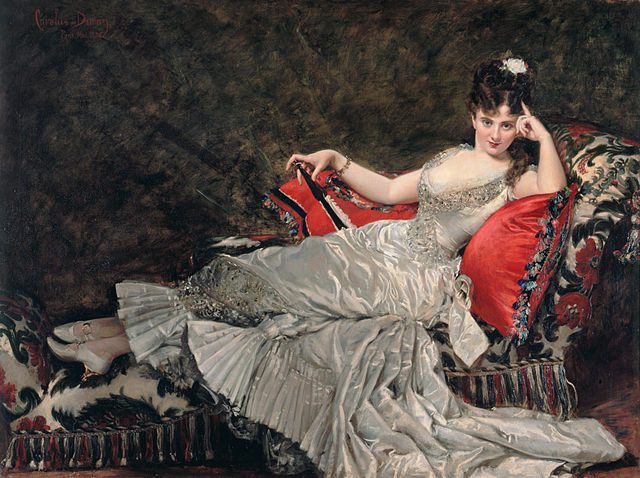
Emile-Auguste Carolus-Duran, a name synonymous with elegance and mastery in 19th-century portraiture, transcended his time as both an artist and a teacher. Known for his innovative approach to painting and his profound influence on a new generation of artists, Carolus-Duran bridged traditional techniques with modern artistic philosophies. His bold style, characterized by dramatic lighting and vibrant brushstrokes, left an indelible mark on the art world.
Beyond his celebrated paintings, Carolus-Duran was a mentor to some of the most influential artists of the Impressionist and post-Impressionist movements, including John Singer Sargent. His teaching philosophy championed technical skill alongside personal expression, a revolutionary idea in his era. This biography delves into the life, works, and enduring legacy of a man whose art continues to captivate audiences and inspire generations.
Early Life and Background
Charles-Émile-Auguste Durand, later known as Carolus-Duran, was born on July 4, 1837, in the bustling city of Lille, France. Raised in a modest family, his early life was shaped by the cultural vibrancy of Lille, a city known for its rich artistic traditions. Even as a child, he displayed a fascination with art, sketching scenes from everyday life and studying the natural world around him.

His formal education began at the Lille Academy of Fine Arts, where his teachers quickly recognized his exceptional talent. Encouraged by their support, he developed foundational skills that would later distinguish him as a master portraitist. Lille’s proximity to Paris, the epicenter of the European art world, exposed Carolus-Duran to burgeoning artistic movements that influenced his early works.
However, his aspirations extended far beyond Lille. Determined to immerse himself in the heart of the art world, Carolus-Duran moved to Paris in the late 1850s. Here, he encountered the dynamic interplay between Romanticism and Realism, two movements that dominated the era. These influences informed his emerging style, combining emotional depth with a keen attention to detail.
Despite his talent, Carolus-Duran’s journey was not without obstacles. Financial struggles plagued his early years in Paris, compelling him to take on commissions to sustain his studies. Yet, his perseverance paid off as he steadily gained recognition within the competitive Parisian art scene.
The Formative Years: Artistic Training
Carolus-Duran’s artistic education blossomed at the Académie Suisse in Paris, a vibrant hub for aspiring artists. The academy fostered a spirit of experimentation, allowing students to explore various styles and techniques. During this time, he forged friendships with contemporaries like Édouard Manet, whose bold approach to painting left a lasting impression on him.
In pursuit of artistic excellence, Carolus-Duran embarked on a transformative journey to Italy and Spain. His time in Rome exposed him to the grandeur of Renaissance art, particularly the works of Titian and Caravaggio. These masters’ dramatic use of light and shadow deeply influenced his aesthetic sensibilities.

However, it was in Spain that Carolus-Duran discovered his greatest inspiration: Diego Velázquez. Fascinated by Velázquez’s naturalism and fluid brushwork, he spent countless hours studying the Spanish master’s paintings. This period marked a turning point in his career, as he adopted Velázquez’s technique of painting directly onto the canvas without preparatory sketches.
Upon returning to France, Carolus-Duran integrated these influences into his work, creating a style that was both technically sophisticated and emotionally resonant. His training abroad enriched his artistry, enabling him to blend the precision of classical techniques with the boldness of contemporary movements.
Rise to Prominence: Establishing a Reputation
Carolus-Duran’s career ascended rapidly following his debut at the Paris Salon in 1866. His painting, “The Murdered Man,” captivated critics and audiences with its dramatic composition and emotional intensity. This breakthrough moment signaled his arrival as a formidable talent in the French art world.
Three years later, he solidified his reputation with “Lady with a Glove,” an exquisite portrait of his wife, Pauline Croizette. This work, celebrated for its lifelike rendering and striking use of color, became one of his most iconic pieces. Its success earned him widespread acclaim and attracted commissions from aristocrats and intellectuals across Europe.

Carolus-Duran’s portraits stood out for their ability to convey not just physical likeness but also the personality and spirit of his subjects. This distinctive approach resonated with patrons, who sought him out to immortalize their images on canvas. His clientele included members of the European elite, further establishing his status as a sought-after portraitist.
As his fame grew, Carolus-Duran expanded his studio, employing assistants and cultivating a network of influential patrons. By the 1870s, he was a central figure in Parisian art circles, admired for both his talent and his innovative approach to portraiture.
Personal Life and Relationships
In 1868, Carolus-Duran married Pauline Croizette, a talented artist and sculptor in her own right. Their partnership was one of mutual respect and collaboration, with Pauline often serving as his muse. Their marriage produced a family deeply immersed in the arts, including their daughter Marie-Anne, who followed in her father’s footsteps as a painter.

The Durans’ home in Paris became a lively cultural salon, hosting prominent artists, writers, and intellectuals. Carolus-Duran’s friendships with figures like Édouard Manet and Edgar Degas reflected his integration into the vibrant artistic community of the time. These relationships were marked by an exchange of ideas that enriched his own artistic practice.
Despite his professional success, Carolus-Duran remained devoted to his family. Pauline’s influence extended beyond their personal life, as her sharp artistic sensibilities often informed his work. Together, they created an environment where creativity and collaboration flourished.
Master of Portraiture: Style and Technique
Carolus-Duran’s portraits are celebrated for their boldness, vibrancy, and emotional depth. His technique, rooted in the naturalism of Velázquez, eschewed the rigid formalities of academic painting. By working directly on the canvas without preliminary drawings, he achieved a sense of immediacy and spontaneity in his work.
One of the defining features of his style was his dramatic use of lighting, which enhanced the three-dimensional quality of his subjects. This approach, combined with his keen eye for detail, gave his portraits a lifelike presence that captivated viewers. His ability to render texture, from the softness of fabric to the sheen of jewelry, further demonstrated his technical mastery.
Carolus-Duran’s portraits were not mere depictions; they were narratives. Each painting captured the essence of the sitter, revealing their character and status. This skill made him a favorite among Europe’s elite, who saw his work as a means of immortalizing their legacies.
His innovative techniques influenced his contemporaries and set new standards for portraiture. By challenging traditional conventions, Carolus-Duran paved the way for more expressive and dynamic forms of artistic representation.
Teacher and Mentor: Influencing the Impressionists
As a teacher, Carolus-Duran’s impact was profound. His Parisian studio attracted students from across Europe and the United States, drawn by his reputation as a master artist. Among his most notable protégés was John Singer Sargent, whose celebrated portraits owe much to Carolus-Duran’s guidance.
Carolus-Duran’s teaching philosophy emphasized the study of Old Masters while encouraging students to develop their own styles. He believed in fostering creativity and individuality, a departure from the rigid methods of traditional academies. This approach resonated with young artists eager to break free from academic constraints.
Beyond Sargent, Carolus-Duran mentored many artists who contributed to the Impressionist movement. His openness to new ideas and his emphasis on technical excellence inspired a generation of painters who sought to innovate while respecting tradition.
His studio became a hub of artistic experimentation and collaboration, shaping the trajectory of modern art. Carolus-Duran’s influence as a mentor extended far beyond his own lifetime, leaving a lasting legacy in the art world.
Later Career and Public Recognition
Carolus-Duran’s later years were marked by continued acclaim and recognition. He remained a sought-after portraitist, completing commissions for royalty, politicians, and prominent cultural figures. His adaptability allowed him to stay relevant in an art world undergoing rapid change.
In 1900, he was awarded the Grand Cross of the Legion of Honor, one of France’s highest distinctions. This honor reflected his contributions to the arts and his enduring impact on French culture.

He participated in major exhibitions throughout Europe, showcasing his works to an international audience. His portraits, celebrated for their technical brilliance and emotional depth, continued to captivate viewers.
Despite his advancing age, Carolus-Duran maintained his passion for art and education. He continued to mentor young artists, sharing his knowledge and inspiring the next generation. His dedication to his craft remained unwavering until his death in 1917.
Death and Legacy
Emile-Auguste Carolus-Duran died on February 17, 1917, in Paris. His passing marked the end of a remarkable career, but his legacy endured. He was laid to rest in Montparnasse Cemetery, surrounded by the cultural luminaries of his time.
Carolus-Duran’s influence extended far beyond his own works. His teachings, embodied by the success of his students, reshaped the trajectory of modern painting. Museums worldwide preserve and display his paintings, ensuring his contributions remain accessible to future generations.
As both an artist and a mentor, Carolus-Duran left an indelible mark on the art world. His innovative techniques and commitment to fostering talent continue to inspire, solidifying his place in history as a transformative figure in 19th-century art.
Key Takeaways
- Carolus-Duran was a master portraitist and influential teacher.
- His style was characterized by bold brushwork and lifelike depictions.
- He mentored notable artists like John Singer Sargent and Jules Bastien-Lepage.
- Iconic works like “Lady with a Glove” defined his career.
- His legacy shaped modern portraiture and art education.
FAQs
- Who was Emile-Auguste Carolus-Duran?
A celebrated French portraitist and influential mentor in 19th-century art. - What is Carolus-Duran known for?
His innovative portrait style and his mentorship of Impressionist-era artists. - Who were his most famous students?
John Singer Sargent, Jules Bastien-Lepage, and Theodore Robinson. - What are his most iconic works?
“Lady with a Glove” and “The Murdered Man” are among his most famous pieces. - How did Carolus-Duran influence modern art?
Through his innovative techniques and his role as a mentor to emerging artists.




